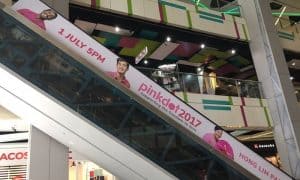There are plenty of things that could go right or wrong in the world of advertisement. And over the years, our little island has unleashed unto the world some pretty interesting ads that are impressionable and have set people talking. Some of them are shocking, some just downright cringe-inducing, and others… Are a little controversial, to say the least.
Here are some local ads that have grabbed our attention and divided our local netizens into different camps.
1. Circles.Life

Kicking things off with one of the most recent ads to gain flak from our netizens, Circles.Life was recently criticized for its visual style and tone that it took for its latest campaign. The language style seemingly resembles the campaigns of humanitarian aid organizations which raises awareness towards social causes and humanity issues… Such as poverty.
In a Facebook post that has gone viral, Hazirah Mohamad calls it “insensitive and dismissive of a real global problem, especially when juxtaposed with what can clearly be seen as a first world problem.” Some creatives in the industry also shared similar sentiments, such as renowned creative director Farrokh Madon, who called it “distasteful in how it equated data deprivation with starvation.”
Of course on the other side of the fence, there are netizens who think that such sentiments are an “overreaction”. Commenting on Hazirah’s post, netizen Kwan Ming Qi calls the campaign “creative marketing” and adds that Singaporeans shouldn’t get so “over-sensitive and butt hurt over little things like that.”
Responding to all the hoo-hah, Circles.Life thanked netizens for their feedback, and that they would “include it to the next round of process updates”. One thing’s for sure, the marketing team has achieved what it originally set out to do, and the telco company is getting tons of publicity because of this.
2. Resorts World Sentosa

If you’ve been to Bugis Village, Clarke Quay or Hotel Rendezvous lately, no doubt you would’ve spotted this attention-grabbing marble wall which commemorates the innocent lives that were taken in the “Southpoint Mall Collapse” (not a real tragedy of course).
This execution by Resorts World Sentosa is for its upcoming Halloween Horror Nights 7 event. Reactions to the marketing campaign were mixed, with some netizens calling it “insensitive” as it is currently the Chinese Ghost Month. Since a significant part of our Singaporean Chinese population share some traditional superstitions (especially when it comes to the Ghost Festival), it’s easy to see why this campaign is viewed as a case of bad taste and terrible timing.
However, there were also netizens who defended the ad, calling it “clever” and a great way to draw the attention of the masses. Netizen Kevin Choy commented on Resorts World Sentosa’s post, saying “Kudos to the marketing and promo team! This is the type of out of the box creativity that we need!”
What do you think? Insensitive considering the time of the year? Or a strong marketing game on RWS’ part?
3. Abercrombie & Fitch

Known for their racy advertisements which often feature models in various states of undress, Abercrombie & Fitch came under fire in 2011 for a billboard ad that features a man’s navel and some very low hanging jeans. Many felt that the image on the billboard was too explicit, while others felt that the other camp held a too traditional view for the 21st century.
The ad was eventually suspended by Media Development Authority (MDA) and the Advertising Standards Authority of Singapore (ASAS). Speaking about the ad, ASAS chairman Tan Sze Wee said, “The general consensus was that the portrayal of the human anatomy had crossed the path of decency because the navel line was very much exposed.”
No matter where your opinion leans towards, the issue primarily seems to be about the Asian culture and views on nudity. Although Singapore is a modern society, the general mindset and consensus is still very much conservative, much like all the other Asian societies. If this was put up in the United States, the billboard ad would barely cause anyone to bat an eyelid.
This event leads us to question, how much of the Westernized concepts are Singaporeans ready or willing to accept? Abercrombie & Fitch has long relied on sexy ad campaigns to sell its products, and I would be hard pressed to believe that nobody saw this coming when the retailer arrived on our shores.
4. I Love Children

You might’ve seen the cartoons advocating early parenthood plastered all over City Hall MRT last year. The cartoons depict sperm and eggs in activities together such as rowing a boat or playing darts. Along with slogans such as “Fertility is a gift with an expiry date” and “Women are born with a finite number of eggs”, it’s easy to see why many people had things to say about it.
The Association of Women for Action and Research (AWARE) has called the campaign “scaremongering”, saying that it might have an emotional impact on women who are infertile or who have experienced miscarriages. “Having a child is a personal choice,” says AWARE programmes and communications senior manager Jolene Tan. “It’s not appropriate and inclusive for ILC to set a universal pattern for what people’s family lives should be like. This campaign is not helpful, it seems designed to cause anxiety and put pressure on people, rather than giving them a nuanced understanding of fertility.”
On The Independent, writer Ghui doesn’t mince words either by saying, “There are many single parents amongst us who would rightfully roll their eyes at the blatant hypocrisy of these posters.” Many citizens who’ve seen the advertisements also said that they did not wish to be told what to do.
However, ILC president Joni Ong defends the campaign, saying “Yes, these advertisements are very much in your face, but they generated talk that we didn’t get in previous years when our visuals were more muted. If this leads to more awareness, then it is good.”
It seems that to ILC, all publicity is good publicity. However, Singaporeans are a well-educated lot. We can make decisions for ourselves, and we most certainly don’t need to be told of whether or not we should have children.
5. Singapore Tourism Board
We received international spotlight for this promotional ad in 2014 – and not in a good way – but because it’s “so bad, it will go viral”.
The video was widely ridiculed on social media channels, prompting the Singapore Tourism Board to pull the video off their Youtube channel. But not before other users managed to download it and repost it on their own channels. All across the board, you can see comments from netizens such as “cringeworthy”, “terrible” and “awkward”.
Sure enough, with the bad dubbing, air-headed lines, and banal soundtrack, this promotional video should be taken as a case study for what not to do in an advertisement.
Upon the backlash, STB moved to distance itself from the production, saying that the ad was produced by the Philippines network ABS-CNB… Which probably made it even more of a PR disaster. As mentioned by The Mothership, “It was a missed chance on STB’s part to have a conversation with social media opinion leaders who shared the video.”
It should also be noted that this campaign was to encourage more Filipinos to visit Singapore, so Singaporeans weren’t even the intended audience. And before the video was taken down, it actually received many likes, shares, and even positive comments by the local Filipinos. One of them was netizen Jennifer Morales who commented, “I love your advertisement. Good job!”
Sadly, by deleting the post, STB also erased all traces of positivity.
6. Pink Dot

Earlier this year, Cathay Cineleisure unveiled a Pink Dot 2017 advertisement that offended some netizens so much that even police reports were lodged. These netizens are part of a Facebook group called “We are against Pink Dot in Singapore”, and in their discussions, they heavily criticised both the Pink Dot organisers and Cathay Cineleisure mall for displaying the ad. Some netizens also proclaimed that they would boycott the mall.
A Cathay spokesperson responded that as an entertainment company, it has always believed in an all-inclusive society where there is a place for everyone to call home. “This is and has always been in line with our mission of bringing people together. We hope to inspire people to embrace the values of equality where one can live and love freely,” the spokesperson added.
Advertising Standards Authority of Singapore (ASAS) weighed in on the situation and explained that the Pink Dot organisers have the necessary permit to promote the event, as long as all advertisements are “legal, decent, honest and truthful”. They did, however, advise Cathay Cineleisure to remove the phrase “Supporting the freedom to love” as it may “affect public sensitivities due to the issues at hand”.
Cathay declined to follow the advice, as “the ownership of the ad belongs to Pink Dot and Cathay is not in the position to decide on the removal of the statement”. Not long after, an 8-metre long, 2.5-metre high Pink Dot advertisement was placed at the front entrance of the mall. Many netizens in support of the Pink Dot movement saw this as a “clap back” and an act of defiance. However, Pink Dot and Cathay issued a response to clarify that the advertisement had been planned all along.
Still, that was no deterrent for many of the netizens, such as Jun Cai and Romee Ramli, who said they were going to show their support by shopping and catching more movies at Cathay Cineleisure, and also urged other netizens to do the same.




















